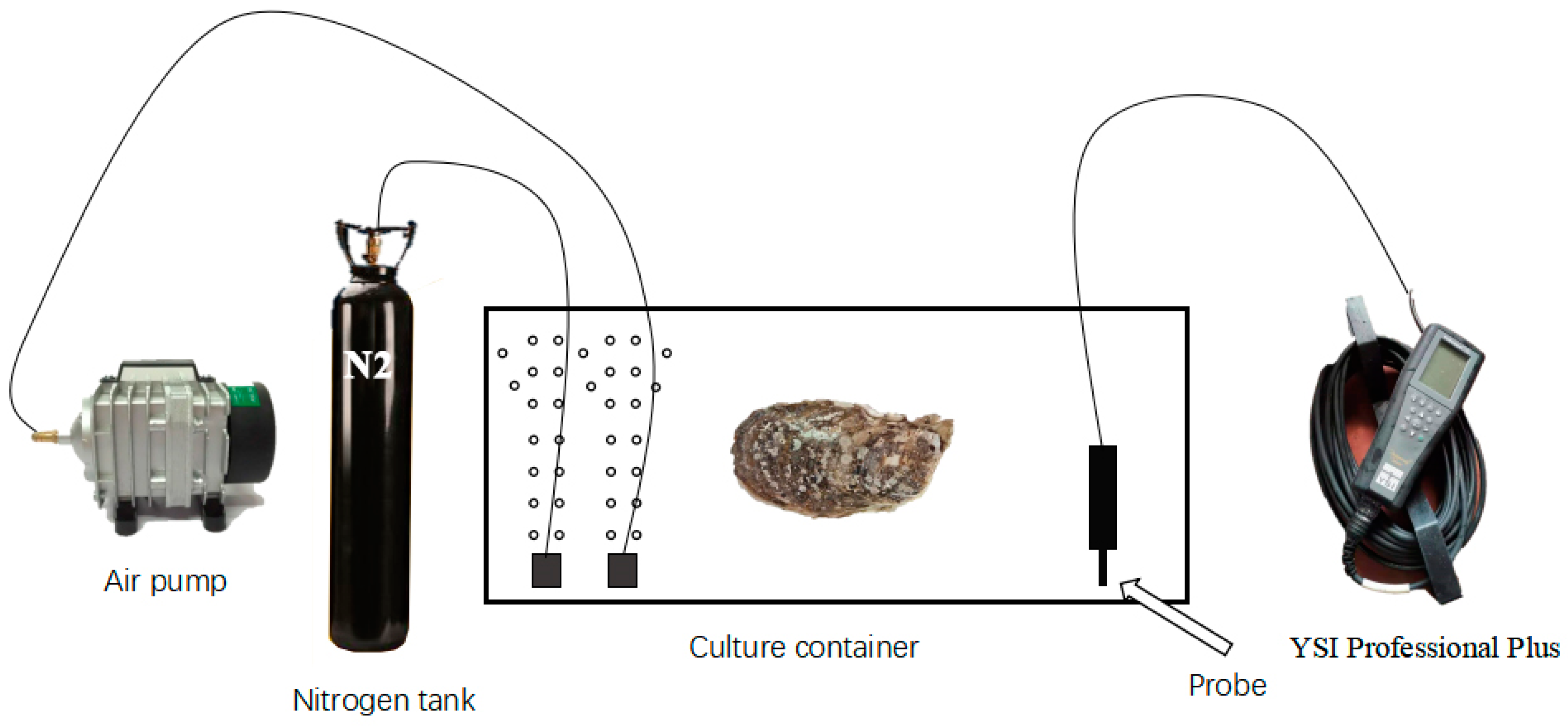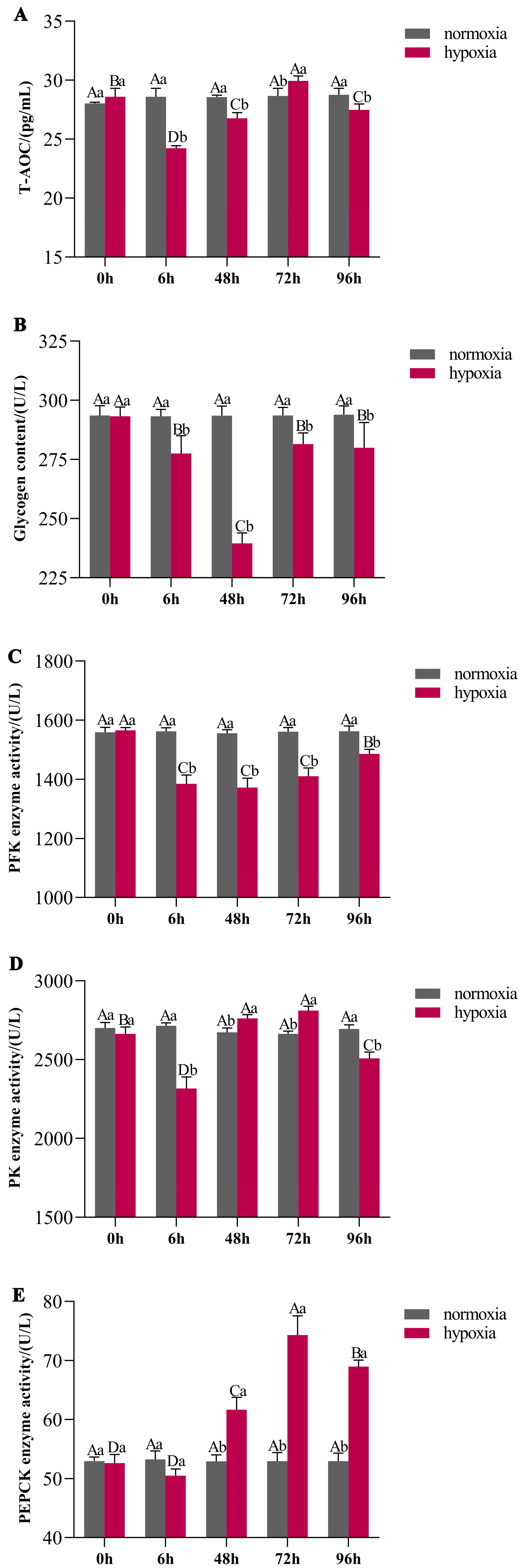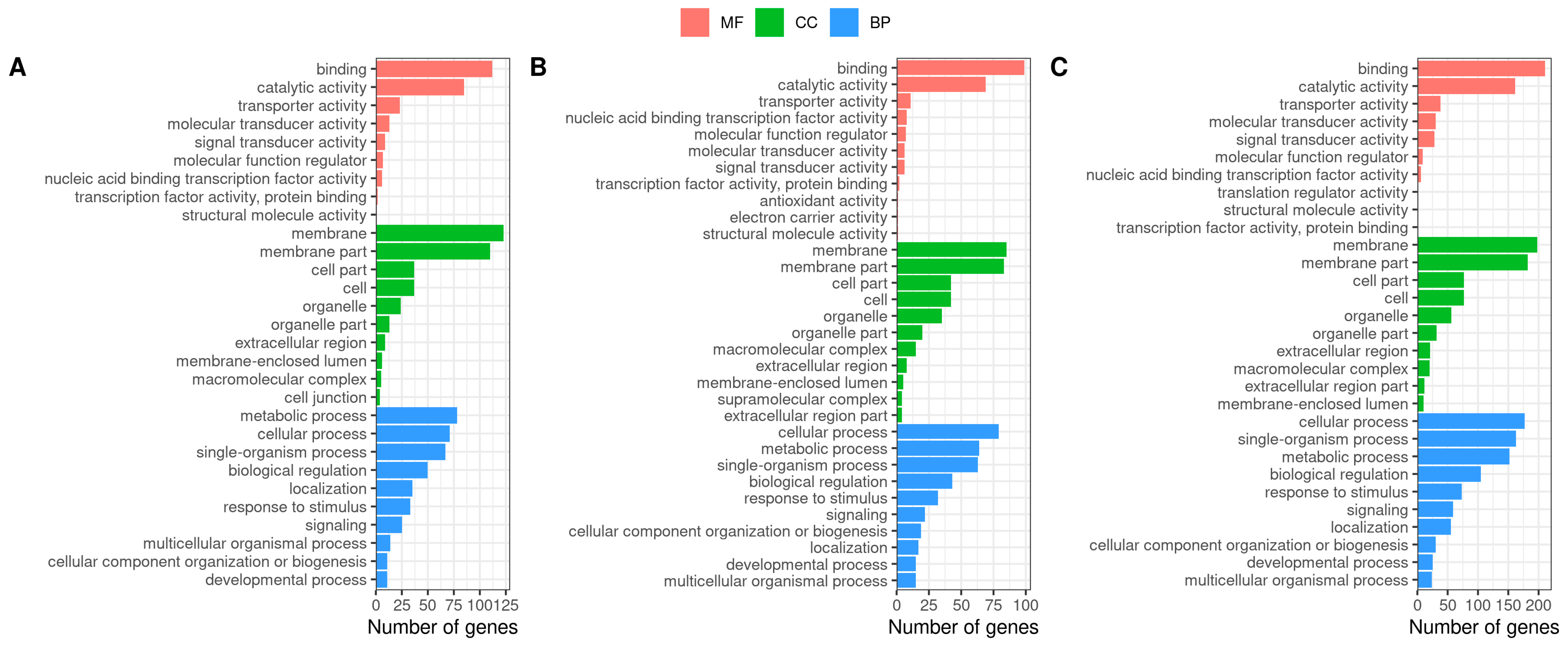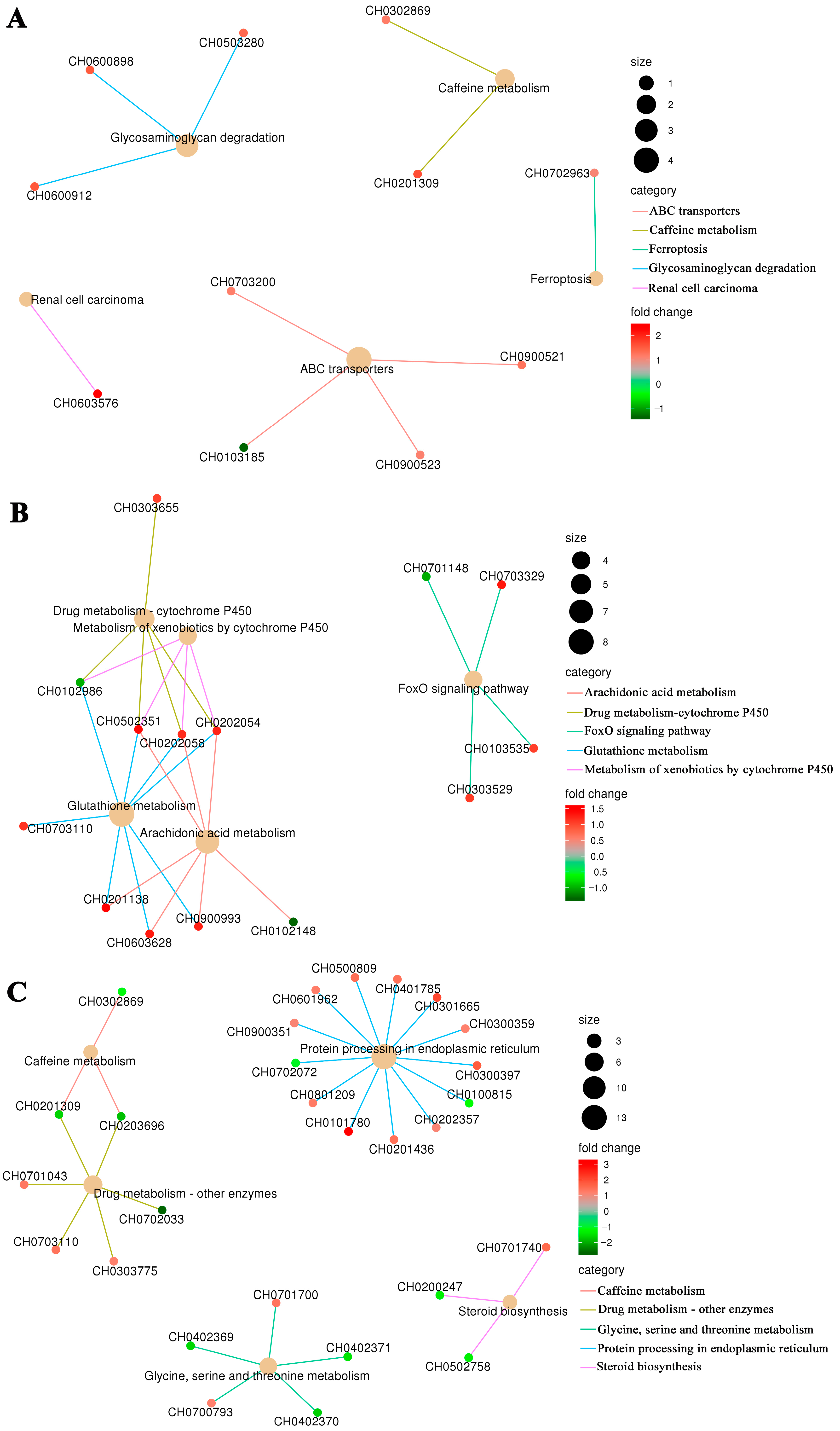Antioxidant Capacity, Enzyme Activities Related to Energy Metabolism, and Transcriptome Analysis of Crassostrea hongkongensis Exposed to Hypoxia
Abstract
:1. Introduction
2. Materials and Methods
2.1. Hypoxia Experiment
2.2. Antioxidant Capacity and Enzyme Activity Determination
2.3. RNA Extraction and Sequencing
2.4. Sequence Processing and Functional Annotation
2.5. Analysis of DEGs
2.6. Real-Time Quantitative Polymerase Chain Reaction (RT-qPCR)
3. Results
3.1. Antioxidant Capacity, Glycogen Content, and Enzyme Activities
3.2. Sequencing, Sequence Assembly, and Annotation
3.3. Candidate Genes under Hypoxic Conditions
3.4. Functional Annotation of DEGs under Hypoxic Conditions in C. hongkongensis
3.5. KEGG Pathway Network Enriched by DEGs
3.6. RT-qPCR Confirmation of DEGs
4. Discussion
5. Conclusions
Supplementary Materials
Author Contributions
Funding
Institutional Review Board Statement
Informed Consent Statement
Data Availability Statement
Conflicts of Interest
References
- Gong, S.B.; Gao, A.G.; Ni, G.T.; Zhu, X.X.; Zhang, Y.P.; Hou, Y.T. Progress in Research of Hypoxia in Estuaries and Coastal Areas in China. Water Resour. Prot. China 2017, 33, 62–69. [Google Scholar]
- Wang, T. The Molecular Mechanism of Hypoxia Signal Pathway in the Pacific Oyster (Crassostrea gigas). Ph.D. Thesis, Institute of Oceanology, Chinese Academy of Sciences, Beijing, China, 2017. [Google Scholar]
- Rabalais, N.N.; Turner, R.E.; Wiseman, W.J., Jr. Hypoxia in the Gulf of Mexico. J. Environ. Qual. 2001, 30, 320–329. [Google Scholar] [CrossRef] [PubMed]
- Jeppesen, R.M.; Rodriguez, M.; Rinde, J.; Haskins, J.; Hughes, B.B.; Mehner, L.; Wasson, K. Effects of Hypoxia on Fish Survival and Oyster Growth in a Highly Eutrophicestuary. Estuar. Coasts 2016, 41, 89–98. [Google Scholar] [CrossRef]
- Vaquer-Sunyer, R.; Duarte, C.M. Thresholds of Hypoxia for Marine Biodiversity. Proc. Natl. Acad. Sci. USA 2008, 105, 15452–15457. [Google Scholar] [CrossRef]
- Lam, K.; Morto, B. The Oysters of Hong Kong (Bivalvia: Ostreidae and Gryphaeidae). Raffles Bull. Zool. 2004, 52, 11–28. [Google Scholar]
- Li, X. Studies on the Nutrient Budgets and Characteristics of Hypoxia in the Changjiang Estuary Key Laboratory of Marine Ecology and Environmental Science. Ph.D. Thesis, Institute of Oceanology, Chinese Academy of Sciences, Beijing, China, 2011. [Google Scholar]
- Zhang, W.B.; Lu, Z.B.; Zhang, Y.; Chen, J.Q.; Li, F.; Zheng, L.; Cong, X.R. Influence of Hypoxia Stress on Physiological Metabolism of Ruditapes philippinarum. Chin. J. Ecol. 2014, 33, 6. [Google Scholar]
- Sobral, P.; Widdows, J. Influence of Hypoxia and Anoxia on the Physiological Responses of the Clam Ruditapes decussatus from Southern Portugal. Mare Biol. 1997, 127, 455–461. [Google Scholar] [CrossRef]
- Baker, S.M.; Mann, R. Effects of Hypoxia and Anoxia on Larval Settlement, Juvenile Growth, and Juvenile Survival of the Oyster Crassostrea virginica. Biol. Bull. 1992, 182, 265–269. [Google Scholar] [CrossRef]
- Wei, S.S.; Xie, Z.; Liu, C.H.; Sokolova, I.; Sun, B.Y.; Mao, Y.R.; Xiong, K.; Peng, J.X.; Fang, J.K.H.; Hu, M.H.; et al. Antioxidant Response of the Oyster Crassostrea hongkongensis Exposed to Diel-cycling Hypoxia under Different Salinities. Mar. Environ. Res. 2022, 179, 105705. [Google Scholar] [CrossRef]
- Greenway, S.C.; Storey, K.B. Effects of Seasonal Change and Prolonged Anoxia on Metabolic Enzymes of Littorina littorea. Can. J. Zool. 2001, 79, 907–915. [Google Scholar] [CrossRef]
- Le Moullac, G.; Bacca, H.; Huvet, A.; Moal, J.; Pouvreau, S.; Van Wormhoudt, A. Transcriptional Regulation of Pyruvate Kinase and Phosphoenolpyruvate Carboxykinase in the Adductor Muscle of the Oyster Crassostrea gigas during Prolonged Hypoxia. J. Exp. Zool. A Ecol. Genet. Physiol. 2007, 307, 371–382. [Google Scholar] [CrossRef]
- Yan, L.L.; Li, Y.C.; Wang, Z.P.; Su, J.Q.; Yu, R.H.; Yan, X.W.; Ma, P.Z.; Cui, Y.T. Stress Response to Low Temperature: Transcriptomic Characterization in Crassostrea sikamea × Crassostrea angulata Hybrids. Aquac. Res. 2018, 49, 3374–3385. [Google Scholar] [CrossRef]
- Meng, X.L.; Liu, M.; Jiang, K.Y.; Wang, B.J.; Tian, X.; Sun, S.J.; Luo, Z.Y.; Qiu, C.W.; Wang, L. De Novo Characterization of Japanese Scallop Mizuhopecten yessoensis Transcriptome and Analysis of Its Gene Expression Following Cadmium Exposure. PLoS ONE 2013, 8, e64485. [Google Scholar] [CrossRef]
- Li, W.; Zhang, X.Z.; He, P.P.; Jiang, L.Y.; Zhang, L.; Guan, J.L.; Chen, Y.X.; Zheng, Y.S.; Wei, P.Y.; Peng, J.X. Transcriptional Responses of Crassostrea hongkongensis under High and Low Salinity Stress. Comp. Biochem. Physiol. Part. D Genom. Proteom. 2024, 49, 101188. [Google Scholar] [CrossRef]
- Hall, S.; Méthé, D.; Stewart-Clark, S.; Clark, F. Size and Site Specific Transcriptomic Responses of Blue Mussel (Mytilus Edulis) to Acute Hypoxia. Mar. Genom. 2023, 71, 101060. [Google Scholar] [CrossRef] [PubMed]
- Yang, C.Y.; Wu, H.L.; Chen, J.Y.; Liao, Y.S.; Mkuye, R.; Deng, Y.W.; Du, X.D. Integrated Transcriptomic and Metabolomic Analysis Reveals the Response of Pearl Oyster (Pinctada fucata martensii) to Long-term Hypoxia. Mar. Environ. Res. 2023, 191, 106133. [Google Scholar] [CrossRef] [PubMed]
- Zhang, Q.; Lu, Y.Q.; Zheng, H.P.; Liu, H.L.; Li, S.K. Differential Immune Response of Vitellogenin Gene to Vibrio Anguillarum in Noble Scallop Chlamys nobilis and Its Correlation with Total Carotenoid Content. Fish Shellfish Immunol. 2016, 50, 11–15. [Google Scholar] [CrossRef]
- Pertea, M.; Pertea, G.M.; Antonescu, C.M.; Chang, T.C.; Mendell, J.T.; Salzberg, S.L. StringTie Enables Improved Reconstruction of a Transcriptome from RNA-seq Reads. Nat. Biotechnol. 2015, 33, 290–295. [Google Scholar] [CrossRef]
- Buchfink, B.; Xie, C.; Huson, D.H. Fast and Sensitive Protein Alignment using DIAMOND. Nat. Methods 2015, 12, 59–60. [Google Scholar] [CrossRef]
- Deng, Y.Y.; Li, J.Q.; Wu, S.F.; Zhu, Y.P.; Chen, Y.W.; He, F.C. Integrated Nr Database in Protein Annotation System and Its Localization. Chin. J. Comput. Eng. 2006, 32, 71–74. [Google Scholar]
- Apweiler, R.; Bairoch, A.; Wu, C.H.; Barker, W.C.; Boeckmann, B.; Ferro, S.; Gasteiger, E.; Huang, H.Z.; Lopez, R.; Magrane, M.; et al. UniProt: The Universal Protein Knowledgebase. Nucleic Acids Res. 2004, 32, D115–D119. [Google Scholar] [CrossRef] [PubMed]
- Tatusov, R.L.; Galperin, M.Y.; Natale, D.A. The COG database: A Tool for Genome Scale Analysis of Protein Functions and Evolution. Nucleic Acids Res. 2000, 28, 33–36. [Google Scholar] [CrossRef] [PubMed]
- Ashburner, M.; Ball, C.A.; Blake, J.A.; Botstein, D.; Butler, H.; Cherry, J.M.; Davis, A.P.; Dolinski, K.; Dwight, S.S.; Eppig, J.T.; et al. Gene Ontology: Tool for the Unification of Biology. The Gene Ontology Consortium. Nat. Genet. 2000, 25, 25–29. [Google Scholar] [CrossRef] [PubMed]
- Koonin, E.V.; Fedorova, N.D.; Jackson, J.D.; Jacobs, A.R.; Krylov, D.M.; Makarova, K.S.; Mazumder, R.; Mekhedov, S.L.; Nikolskaya, A.N.; Rao, B.S.; et al. A Comprehensive Evolutionary Classification of Proteins Encoded in Complete Eukaryotic Genomes. Genome Biol. 2004, 5, R7. [Google Scholar] [CrossRef]
- Young, M.D.; Wakefield, M.J.; Smyth, G.K.; Oshlack, A. Gene Ontology Analysis for RNA-seq: Accounting for Selection Bias. Genome Biol. 2010, 11, R14. [Google Scholar] [CrossRef]
- Mao, X.Z.; Cai, T.; Olyarchuk, J.G.; Wei, L.P. Automated Genome Annotation and Pathway Identification Using the KEGG Orthology (KO) as a Controlled Vocabulary. Bioinformatics 2005, 21, 3787–3793. [Google Scholar] [CrossRef]
- Lee, Y.; Byeon, E.; Kim, D.H.; Maszczyk, P.; Wang, M.; Wu, R.S.S.; Jeung, H.D.; Hwang, U.K.; Lee, J.S. Hypoxia in Aquatic Invertebrates: Occurrence and Phenotypic and Molecular Responses. Aquat. Toxicol. 2023, 263, 106685. [Google Scholar] [CrossRef]
- Collins, M.; Truebano, M.; Verberk, W.C.E.P.; Spicer, J.I. Do Aquatic Ectotherms Perform Better under Hypoxia After Warm Acclimation? J. Exp. Biol. 2021, 224, jeb232512. [Google Scholar] [CrossRef]
- Mandic, M.; Flear, K.; Qiu, P.; Pan, Y.K.; Perry, S.F.; Gilmour, K.M. Aquatic Surface Respiration Improves Survival During Hypoxia in Zebrafish (Danio rerio) Lacking Hypoxia-Inducible Factor 1-α. Proc. Biol. Sci. 2022, 289, 20211863. [Google Scholar] [CrossRef]
- David, E.; Tanguy, A.; Pichavant, K.; Moraga, D. Response of the Pacific Oyster Crassostrea gigas to Hypoxia Exposure under Experimental Conditions. FEBS J. 2010, 272, 5635–5652. [Google Scholar] [CrossRef]
- Li, Q.; Sun, S.; Zhang, F.; Wang, M.X.; Li, M.N. Effects of Hypoxia on Survival, Behavior, Metabolism and Cellular Damage of Manila Clam (Ruditapes philippinarum). PLoS ONE 2019, 14, e0215158. [Google Scholar] [CrossRef]
- Jing, H.; Liu, Z.H.; Wu, B.; Tu, K.; Liu, Z.M.; Sun, X.J.; Zhou, L.Q. Physiological and Molecular Responses to Hypoxia Stress in Manila Clam Ruditapes philippinarum. Aquat. Toxicol. 2023, 257, 106428. [Google Scholar] [CrossRef]
- Larade, K.; Storey, K.B. A Profile of the Metabolic Responses to Anoxia in Marine Invertebrates. Cell Mol. Response Stress 2002, 3, 27–46. [Google Scholar]
- Yang, C.Y.; Wang, X.B.; Zhou, K.; Jiang, D.L.; Shan, Y.; Wang, L.L.; Song, L.S. Effect of High Temperature Stress on Glycogen Metabolism in Gills of Yesso Scallop Patinopecten yessoensis. Fish Shellfish Immunol. 2023, 138, 108786. [Google Scholar] [CrossRef] [PubMed]
- Meng, J.; Wang, T.; Li, L.; Zhang, G. Inducible Variation in Anaerobic Energy Metabolism Reflects Hypoxia Tolerance Across the Intertidal and Subtidal Distribution of the Pacific Oyster (Crassostrea gigas). Mar. Environ. Res. 2018, 138, 135–143. [Google Scholar] [CrossRef]
- Xu, S.Y.; Mo, Y.H.; Liu, Y.J.; Wang, X.; Li, H.Y.; Yang, W.D. Physiological and Genetic Responses of the Benthic Dinoflagellate Prorocentrum Lima to Polystyrene Microplastics. Harmful Algae 2024, 136, 102652. [Google Scholar] [CrossRef]
- Andreyeva, A.Y.; Gostyukhina, O.L.; Kladchenko, E.S.; Vodiasova, E.A.; Chelebieva, E.S. Acute Hypoxic Exposure: Effect on Hemocyte Functional Parameters and Antioxidant Potential in Gills of the Pacific Oyster, Crassostrea gigas. Mar. Environ. Res. 2021, 169, 105389. [Google Scholar] [CrossRef] [PubMed]
- Amorim, K.; Piontkivska, H.; Zettler, M.L.; Sokolov, E.; Hinzke, T.; Nair, A.M.; Sokolova, I.M. Transcriptional Response of Key Metabolic and Stress Response Genes of a Nuculanid Bivalve, Lembulus Bicuspidatus from an Oxygen Minimum Zone Exposed to Hypoxia-Reoxygenation. Comp. Biochem. Physiol. B Biochem. Mol. Biol. 2021, 256, 110617. [Google Scholar] [CrossRef]
- Wang, Y.H.; Zhang, X.M. The Critical Roles of Mitochondrial Alternative Chains in Juvenile Ark Shells (Anadara broughtonii) Exposed to Acute Hypoxia with or without Sulfide. Aquat. Toxicol. 2021, 241, 105996. [Google Scholar] [CrossRef]
- Yusseppone, M.S.; Rocchetta, I.; Sabatini, S.E.; Luquet, C.M.; Ríos de Molina, M.D.C.; Held, C.; Abele, D. Corrigendum: Inducing the Alternative Oxidase Forms Part of the Molecular Strategy of Anoxic Survival in Freshwaterbivalves. Front. Physiol. 2018, 9, 330. [Google Scholar] [CrossRef]
- Rahman, M.S.; Thomas, P. Molecular Characterization and Expression of Cytochrome P450 Aromatase in Atlantic Croaker Brain: Regulation by Antioxidant Status and Nitric Oxide Synthase During Hypoxia Stress. Front. Physiol. 2021, 12, 720200. [Google Scholar] [CrossRef]
- Zafari, S.; Vanlerberghe, G.C.; Igamberdiev, A.U. The Role of Alternative Oxidase in the Interplay between Nitric Oxide, Reactiveoxygen Species, and Ethylene in Tobacco (Nicotiana tabacum L.) Plants Incubated under Normoxic and Hypoxic Conditions. Int. J. Mol. Sci. 2022, 23, 7153. [Google Scholar] [CrossRef]
- Châtel, A.; Murillo, L.; Bourdin, C.M.; Quinchard, S.; Picard, D.; Legros, C. Characterization of Tyramine β-hydroxylase, an Enzyme Upregulated by Stress in Periplaneta americana. J. Mol. Endocrinol. 2013, 50, 91–102. [Google Scholar] [CrossRef]
- Kuo, H.W. Tyramine Beta Hydroxylase-mediated Octopamine Synthesis Pathway in Litopenaeus vannamei Under Thermal, Salinity, and Vibrio Alginolyticus Infection Stress. Fish Shellfish Immunol. 2023, 142, 109096. [Google Scholar] [CrossRef]
- Kuo, H.W.; Cheng, W. Cloning and Characterization of a Key Enzyme in Octopaminergic Pathway: Tyramine Beta-hydroxylase from Litopenaeus vannamei, as Expressed During Vibrio Alginolytics Infection and Hypothermal Stress. Fish Shellfish Immunol. 2021, 119, 1–10. [Google Scholar] [CrossRef] [PubMed]
- Guzy, R.D.; Schumacker, P.T. Oxygen Sensing by Mitochondria at Complex III: The Paradox of Increased Reactive Oxygen Species During Hypoxia. Exp. Physiol. 2006, 91, 807–819. [Google Scholar] [CrossRef] [PubMed]
- Fridovich, I. The Biology of Oxygen Radicals. Science 1978, 201, 875–880. [Google Scholar] [CrossRef] [PubMed]
- Qian, Z.M.; Xu, M.F.; Tang, P.L. Superoxide Dismutase Does Protect the Cultured Rat Cardiac Myocytes Against Hypoxia/Reoxygenation Injury. Free Radic. Res. 1997, 27, 13–21. [Google Scholar] [CrossRef]
- Gostyukhina, O.L.; Yu, A.A.; Chelebieva, E.S.; Vodiasova, E.A.; Lantushenko, A.O.; Kladchenko, E.S. Adaptive Potential of the Mediterranean Mussel Mytilus galloprovincialis to Short-term Environmental Hypoxia. Fish Shellfish Immunol. 2022, 131, 654–661. [Google Scholar] [CrossRef]
- Pei, X.Y.; Chu, M.X.; Tang, P.; Zhang, H.Y.; Zhang, X.Y.; Zheng, X.; Li, J.; Mei, J.; Wang, T.; Yin, S.W. Effects of Acute Hypoxia and Reoxygenation on Oxygen Sensors, Respiratory Metabolism, Oxidative Stress, and Apoptosis in Hybrid Yellow Catfish "Huangyou-1". Fish Physiol. Biochem. 2021, 47, 1429–1448. [Google Scholar] [CrossRef]
- Tomarev, S.I.; Zinovieva, R.D.; Piatigorsky, J. Characterization of Squid Crystallin Genes. Comparison with Mammalian Glutathione S-transferase Genes. J. Biol. Chem. 1992, 267, 8604–8612. [Google Scholar] [CrossRef] [PubMed]
- Laborde, E. Glutathione Transferases as Mediators of Signaling Pathways Involved in Cell Proliferation and Cell Death. Cell Death Differ. 2010, 17, 1373–1380. [Google Scholar] [CrossRef] [PubMed]
- Saetan, W.; Tian, C.; Yu, J.; Lin, X.; He, F.; Huang, Y.; Shi, H.; Zhang, Y.; Li, G. Comparative Transcriptome Analysis of Gill Tissue in Response to Hypoxia in Silver Sillago (Sillago sihama). Animals 2020, 10, 628. [Google Scholar] [CrossRef] [PubMed]
- Nie, H.T.; Wang, H.M.; Jiang, K.Y.; Yan, X.W. Transcriptome Analysis Reveals Differential Immune Related Genes Expression in Ruditapes philippinarum Under Hypoxia Stress: Potential HIF and NF-κB Crosstalk in Immune Responses in Clam. BMC Genom. 2020, 21, 318. [Google Scholar] [CrossRef]
- Yu, Y.; He, J.; Liu, W.H.; Li, Z.M.; Weng, S.P.; He, J.G.; Guo, C.J. Molecular Characterization and Functional Analysis of Hypoxia-Responsive Factor Prolyl Hydroxylase Domain 2 in Mandarin Fish (Siniperca chuatsi). Animals 2023, 13, 1556. [Google Scholar] [CrossRef]
- Liu, B.H.; Wen, H.S.; Yang, J.; Li, X.H.; Li, G.L.; Zhang, J.R.; Wu, S.X.; Butts, I.A.; He, F. Hypoxia affects HIF-1/LDH-A Signaling Pathway by Methylation Modification and Transcriptional Regulation in Japanese Flounder (Paralichthys olivaceus). Biology 2022, 11, 1233. [Google Scholar] [CrossRef]
- Xiao, W. The Hypoxia Signaling Pathway and Hypoxic Adaptation in Fishes. Sci. China Life Sci. 2015, 58, 148–155. [Google Scholar] [CrossRef]
- Schofield, C.J.; Ratcliffe, P.J. Oxygen Sensing by HIF Hydroxylases. Nat. Rev. Mol. Cell. Biol. 2004, 5, 343–354. [Google Scholar] [CrossRef]
- Zhang, E.H.; Zhang, J.H.; Jin, J.; Qin, J.; Li, H.J.; Huang, L. Variants of the Low Oxygen Sensors EGLN1 and HIF-1AN Associated with Acute Mountain Sickness. Int. J. Mol. Sci. 2014, 15, 21777–21787. [Google Scholar] [CrossRef]
- Nguyen, T.L.; Durán, R.V. Prolyl Hydroxylase Domain Enzymes and Their Role in Cell Signaling and Cancer Metabolism. Int. J. Biochem. Cell Biol. 2016, 80, 71–80. [Google Scholar] [CrossRef]







| mRNA | Sequence (5′–3′) | Length (bp) | |
|---|---|---|---|
| CH1000250 | Fwd | AAGGTGACTTCAACACATCCG | 220 |
| Rev | CCTACTTGGTTTTGCTCGTTAT | ||
| CH1001282 | Fwd | AGAAATGGGGTCAAGGTCG | 119 |
| Rev | TAGCAGGTTCAGGTAACATACAA | ||
| CH0900166 | Fwd | TCCACCATAGGGTCCACG | 242 |
| Rev | CCATTTCCAAAGGTCCGTC | ||
| CH0502591 | Fwd | GGTTATTTAGAAGTGGCGTCA | 102 |
| Rev | GTGTGTACCAGTCCTACTGTCCT | ||
| CH0200562 | Fwd | CAACAATAGAGAGATTCCCGAT | 210 |
| Rev | CTACCTTAAAGTCCTCCGAGC | ||
| GAPDH | Fwd | GGATTGGCGTGGTGGTAGAG | 184 |
| Rev | GTATGATGCCCCTTTGTTGAGTC |
| Sample | Number of Clean Reads | Number of Clean Bases | GC (%) | % ≥ Q30 |
|---|---|---|---|---|
| N1 | 25,206,800 | 7,511,666,510 | 40.8 | 95.56 |
| N2 | 19,802,452 | 5,893,526,304 | 41.43 | 95.32 |
| N3 | 20,465,606 | 6,087,523,020 | 41.01 | 95.31 |
| H1 | 20,647,843 | 6,150,256,584 | 41.19 | 95.32 |
| H2 | 24,095,305 | 7,170,772,744 | 41.7 | 95.47 |
| H3 | 24,502,902 | 7,288,089,524 | 41.72 | 95.65 |
| R1 | 20,244,717 | 6,033,282,358 | 41.11 | 95.45 |
| R2 | 21,361,892 | 6,362,961,796 | 40.9 | 95.26 |
| R3 | 21,484,903 | 6,389,008,412 | 41.5 | 95.75 |
| ID | Gene Description | Log2.Fold Change (H/N) | Log2.Fold Change (R/N) | Log2.Fold Change (R/H) |
|---|---|---|---|---|
| CH0900239 | cytochrome P450 3A11 isoform X2 | 2.07 | - | −1.08 |
| CH0603576 | egl nine homolog 1 isoform X2 (EGLN1) | 2.4 | - | −2.50 |
| CH1000250 | transient receptor potential cation channel subfamily M member 2 (TRPM2) | −2.41 | −2.23 | - |
| CH1001282 | tyramine beta-hydroxylase (TBH) | 1.23 | 2.05 | - |
| CH0900166 | superoxide dismutase (SOD) | −1.09 | −1.27 | - |
| CH0502591 | alternative oxidase, mitochondrial (AOX) | 1.75 | - | - |
| CH0200562 | globin isoform X3 | 4.16 | - | −4.22 |
| CH0502351 | glutathione S-transferase (GST) | - | 1.39 | 1.95 |
| CH0202054 | S-crystallin SL11 | 1.21 | 1.24 | - |
| CH0202058 | S-crystallin SL11-like | - | 1.19 | - |
| CH0102986 | glutathione S-transferase P 1 isoform X1 (GST) | - | −1.01 | - |
| CH0403890 | Phosphoenolpyruvate carboxykinase (PEPCK) | - | - | −1.05 |
| CH0301448 | methionine adenosyltransferase 2 subunit beta (MAT2A) | −1.38 | - | - |
| CH0900455 | asparagine synthetase (ASNS) | 1.55 | - | |
| CH1000346 | cytoplasmic aconitate hydratase isoform X2 | 1.04 | - | −1.52 |
| CH0403169 | carbonyl reductase (CR) | 1.34 | - | |
| CH0201309 | xanthine dehydrogenase/oxidase-like | 1.641 | - | −1.65 |
| CH0302869 | uricase-like | 1.18 | - | −1.11 |
| CH0303655 | senecionine N-oxygenase (SNO) | - | 1.03 | - |
| CH0601326 | xanthine dehydrogenase/oxidase | - | −1.33 | - |
| CH0203696 | xanthine dehydrogenase | - | - | −1.83 |
| Pathway ID | Pathway Term | DEGs Name |
|---|---|---|
| Hypoxia (H) vs. Normoxia (N) | ||
| ko01230 | biosynthesis of amino acids | MAT2A; ASNS; cytoplasmic aconitate hydratase isoform X2 |
| ko00232 | caffeine metabolism | xanthine dehydrogenase/oxidase-like; uricase-like |
| ko00980 | metabolism of xenobiotics by cytochrome P450 | S-crystallin SL11; CR |
| ko04066 | HIF-1 signaling pathway | EGLN1 |
| Reoxygenation (R) vs. Normoxia (N) | ||
| ko00982 | drug metabolism-cytochrome P450 | glutathione S-transferase P 1 isoform X1; S-crystallin SL11; S-crystallin SL11-like; SNO; glutathione S-transferase |
| ko00980 | metabolism of xenobiotics by cytochrome P450 | glutathione S-transferase P 1 isoform X1; S-crystallin SL11; S-crystallin SL11-like; glutathione S-transferase |
| ko00232 | caffeine metabolism | xanthine dehydrogenase/oxidase |
| Reoxygenation (R) vs. Hypoxia (H) | ||
| ko00232 | caffeine metabolism | xanthine dehydrogenase/oxidase-like; xanthine dehydrogenase; uricase-like |
Disclaimer/Publisher’s Note: The statements, opinions and data contained in all publications are solely those of the individual author(s) and contributor(s) and not of MDPI and/or the editor(s). MDPI and/or the editor(s) disclaim responsibility for any injury to people or property resulting from any ideas, methods, instructions or products referred to in the content. |
© 2024 by the authors. Licensee MDPI, Basel, Switzerland. This article is an open access article distributed under the terms and conditions of the Creative Commons Attribution (CC BY) license (https://creativecommons.org/licenses/by/4.0/).
Share and Cite
He, P.; Li, W.; Wei, P.; Jiang, L.; Guan, J.; Ma, Y.; Zhang, L.; Chen, Y.; Zheng, Y.; Zhang, X.; et al. Antioxidant Capacity, Enzyme Activities Related to Energy Metabolism, and Transcriptome Analysis of Crassostrea hongkongensis Exposed to Hypoxia. Antioxidants 2024, 13, 1063. https://doi.org/10.3390/antiox13091063
He P, Li W, Wei P, Jiang L, Guan J, Ma Y, Zhang L, Chen Y, Zheng Y, Zhang X, et al. Antioxidant Capacity, Enzyme Activities Related to Energy Metabolism, and Transcriptome Analysis of Crassostrea hongkongensis Exposed to Hypoxia. Antioxidants. 2024; 13(9):1063. https://doi.org/10.3390/antiox13091063
Chicago/Turabian StyleHe, Pingping, Wei Li, Pinyuan Wei, Linyuan Jiang, Junliang Guan, Yuan Ma, Li Zhang, Yongxian Chen, Yusi Zheng, Xingzhi Zhang, and et al. 2024. "Antioxidant Capacity, Enzyme Activities Related to Energy Metabolism, and Transcriptome Analysis of Crassostrea hongkongensis Exposed to Hypoxia" Antioxidants 13, no. 9: 1063. https://doi.org/10.3390/antiox13091063







